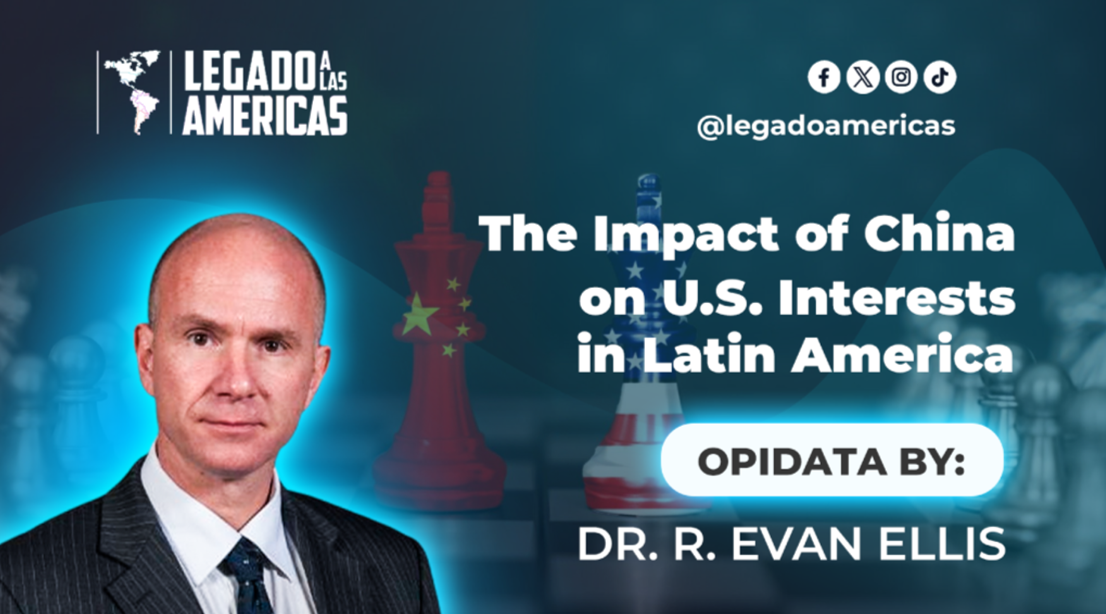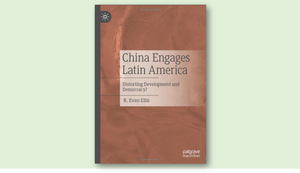
The Impact of China on U.S. Interests in Latin America
The PRC presence in Latin America is principally commercial, although it also includes important political, security, and other strategic dimensions.
President Trump’s statements regarding the influence of the People’s Republic of China (PRC) over the Panama Canal, and the focus on the issue as part of Secretary of State Marco Rubio’s February 2025 trip to Central America and the Caribbean have focused U.S. and global attention on the strategic importance of the challenges posed by PRC in the region most closely connected to the United States by ties of geography, commerce and family. The nature of that threat is real, but broadly misunderstood. The objective of this article is to clarify them.
The PRC presence in Latin America is principally commercial, although it also includes important political, security, and other strategic dimensions. The PRC has become the major commercial partner of virtually every country in the Americas south of Panama, with bilateral trade with the region exceeding $500 billion in 2024 according to the PRC’s own data. Since 2000, PRC-based companies have invested over $193 billion in the region, in hundreds of projects. It’s two principal policy banks, China Development Bank and China Export-Import Bank, have loaned at least $120 billion to the region since 2005. While U.S investment is greater, and while the character of Chinese lending has shifted away from state-to-state loans in recent years, the perceived linkage between the PRC state and its companies magnify the effect of Chinese economic activities, including what political and commercial leaders are willing to do, or not say about the PRC, to not jeopardize access to the Chinese market or PRC-based business partners.
The strategic challenges from PRC engagement in Latin America fall into five categories: adverse economic dynamics, digital risks, people-to-people diplomacy, extended life of anti-US regimes, and options for the PRC in time of war.
With respect to economic effects, although engagement with the PRC can be beneficial for the region under the right circumstances, it often is not, and comes with powerful downsides, particularly when conducted under conditions of weak transparency, with partners with insufficient institutional capacity to structure bids and evaluate contracts in order to ensure the best deal for their people, and to enforce the behavior of Chinese companies allowed to operate in their countries. Chinese companies have experienced particular problems in the region in areas such as corruption, project performance, work quality and contract compliance, labor and environmental laws.
Beyond institutional vulnerabilities, to the extent that the entry of Chinese products displace local manufacturing, or have adverse effects on local communities in the region, those harms impact the U.S. through flows of migrants to the U.S. border. On the other hand, the availability of PRC-based agents to purchase the region’s commodities and finance infrastructure projects by and goods from PRC-based companies, undermines U.S. and other Western influence in the region, including efforts to advance policy objectives such as transparency, a level legal playing field and good governance, as well as U.S. pursuit of broader objectives such as the protection of human rights and the promotion of democracy in the region.
In addition to adverse PRC economic effects on the region itself, the efforts by PRC-based companies to dominate the supply chains for strategic minerals in the region, including lithium deposits in Bolivia, Argentina, Chile and Mexico, and niobium in Brazil, threatens US access to such goods, necessary for US energy and defense uses, at a time in which the PRC is explicitly cutting the US off from access to supply chains for strategic minerals which it controls.
From the standpoint of the U.S., the rush by PRC-based companies within the dynamic of U.S.-China “decoupling” to preserve their access to US markets by investing in Mexico, seeking to legally reinvent themselves as Mexican entities, undermines US government efforts to limit PRC participation in critical supply chains and to protect US industry.
In the digital domain, the growing presence of Chinese companies and products in Latin America puts at risk the ability of the region’s governments and companies to protect the privacy and autonomy of their actions, as well as their ability to protect company and personal data flowing through the region’s infrastructures. The 2017 PRC national security law obliges PRC-based companies to turn over data of national security interest accessible through their devices and services. This obligatory Chinese government access raises significant concerns due to the growing presence of PRC devices and companies in Latin American digital infrastructures, including those in cloud computing, the internet of things, smart and safe cities, commercial and private surveillance systems, ride sharing apps, customs scanners, and even port cranes. The ability of PRC-based companies, with the support of its government, to leverage and lock in its dominant technology and market position in digital sectors through the setting of standards, further magnifies such concerns. Actions by PRC-based hackers against targets in the region, including Flax Typhoon in Paraguay, serve as reminders that the PRC regularly seeks to exploit its digital access to the region for a variety of purposes.
Beyond digitally-based threats, the people-to-people networks that accompany PRC economic and government engagement create risks of both influence and espionage that could be exploited against the US, both politically and commercially during peacetime, as well as during time of conflict. These include Latin-Americans identified by the PRC through its 44 PRC Confucius Institutes in the region, the most promising of whom are awarded scholarships by the Chinese government or by companies such as Huawei for study in the PRC, after which the beneficiaries may return to the region, grateful for the China-funded education that put them on the path to success, going on to China-oriented positions in their foreign ministries or trade promotion organizations, thus representing the interests of their home governments in dealing with the very government that made their education and associated job possible.
A far larger group of persons from the region, including think tank personnel, academics, journalists, politicians, and government functionaries, are brought to the PRC on luxurious and often lucrative trips funded by the Chinese government. The PRC’s own 3-year plan with CELAC speaks of 5,000 scholarships plus another 3,000 training opportunities involving China in a three year period. An Atlantic Council study, examining original Chinese language source documents, found that the number of such programs globally in the 2013-2018 period was ten times greater than in the three decades that had preceded it. While not all of those brought to the PRC are necessarily compromised and exploited for espionage purposes, the sense of gratitude to the Chinese hosts, and hopes for more such invitations in the future, arguably impedes those invited from speaking out as aggressively as they could in public forums about the more problematic dimensions of the PRC and its companies. This is doubly harmful, because the persons invited to the PRC are often those within their country who best understand the PRC and the risks associated with working with it.
Beyond those invited to the PRC itself, the International Liaison Division of the Chinese Communist Party actively maintains connections with China-facing organizations within Latin America and the Caribbean, among other regions. These include interactions with China-facing Chambers of commerce in various countries of the region, as well as China friendship committees, including those in Latin American legislatures.
In the name of providing consular services for ethnic Chinese living in the region, the PRC government also maintains clandestine “police stations.” These entities are known to exploit access to relatives of Chinese Latinamericans, still living in the PRC, to influence their speech and other behavior in the region and possibly extract information from them.
Beyond people-to-people networks, PRC engagement with Latin American governments moving in an anti-democratic, corrupt, and/or anti-US direction, indirectly contributes to the survival of these governments, sustaining their ability to serve as sanctuaries for organized crime groups, the projection of subversive activities elsewhere in the region, or hosts of extra-hemispheric actors hostile to the US such as Russia, Iran, and its surrogate Hezbollah. From 2008 through 2015, for example, the PRC loaned over $59 billion to Venezuela for products and work to be performed by PRC-based companies, repaid with oil pumped out of the country, also by PRC-based companies. The PRC similarly lent almost $12 billion to the anti-US Correa government in Ecuador for a series of infrastructure projects, repaid by deliveries of Ecuadoran oil from PRC-controlled fields. Beyond providing funding for such regimes, the PRC has also sold them military equipment and digital communications, surveillance, and other systems for controlling their own populations. Most notably, these include the ECU-911 and BOL-110 surveillance systems, Venezuela’s “Fatherland Identification Card,” and the telecommunications architecture that enabled the Cuban government’s shut down unexpected July 2021 nationwide protests by cutting protesters off from each other and from the outside world, used the same PRC-provided technology used by China to control its own population.
Finally, the commercial presence and military relationships being built by the PRC in Latin America facilitate options for the PRC to conduct military activities in the Western Hemisphere in support of a war with the US centered on the Indopacific, even if the PRC does not have formal alliances or basing agreements in the former. As examples, PRC-operated ports and other commercial facilities in Mexico the Bahamas, and elsewhere in the Caribbean could be used to project special forces to attack US deployment and sustainment flows from bases on the southeast US coast, or to attack surveillance and command facilities in the region such as JIATF-South. Flows of Chinese immigrants through Central America and Mexico could be used to smuggle PRC military and intelligence personnel across the US border for attacking infrastructure targets in the US. Chinese commercial operations in anti-US countries with trans-oceanic connections, including Honduras and Nicaragua, could be used to receive or store PRC war materiel, and move it between coasts.
Chinese access to space facilities in Venezuela, Bolivia, Chile, Argentina and elsewhere in the region could be used to locate US satellites to later blind or destroy them, or to support attacks from Chinese space-based weapons systems such as its Fractional Orbital Bombardment System. Dual use ports such as the COSCO operated Port of Chancay could be used to resupply PLA warships to support their operation against the US in the Eastern Pacific.
In the context of a global conflict. PRC commercial operations and personnel in Panama could give it the presence and operating knowledge to shut down the canal in deniable ways, at least temporarily. The PRC could use information from its port operations, transits through the canal, and other operations and the presence of Chinese personnel within the canal zone to sabotage the canal locks or otherwise stop canal transits. Further options include sinking a container vessel in a chokepoint like Culebra Cut, reporting the mining of the waterway to scare away commercial ships, or using submarines or other assets outside the canal to put ships waiting to use it at risk.
If the Canal were shut down, PRC operations in other parts of Latin America would take on added strategic significance. These include a commercial port presence the Chinese are pursuing in Ushuaia, in the south of Argentina, in which sensors and weapons could be stored, putting at risk ships the Straits of Magellan and the Drake Passage, as alternatives to the Canal.
In its Foreign policy, the second Trump administration is staffed by personnel with un unprecedented appreciation for both the strategic risks posed by China, and the dynamics and culture of Latin America, as well as its link to US security. The Challenge for the Trump team will be to simultaneously push back on PRC advances in the region and elsewhere, and to pursue US commercial and security interests in the region more broadly, without undermining the relationships and faith in the US in the region, which has historically served as one cornerstone of the region’s willingness to cooperate with and support the U.S. as it pursues its national interests. Indeed, the Trump Administration must be careful that the pressures it puts on the region in pursuit of those interests do not lead its partners to adopt hedging strategies that advance the very presence of China and other anti-US actors that it seeks to oppose.



